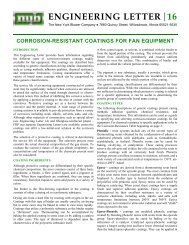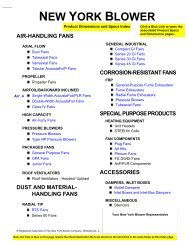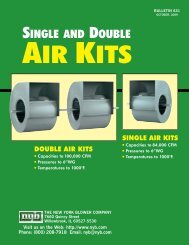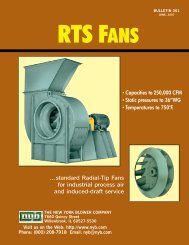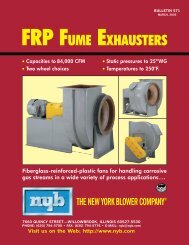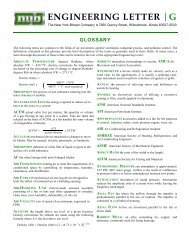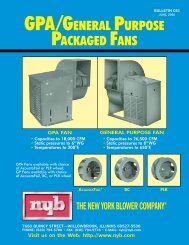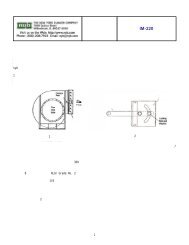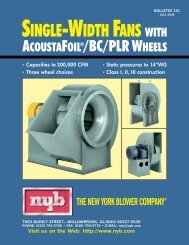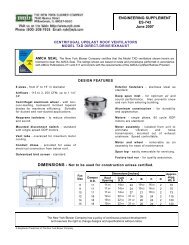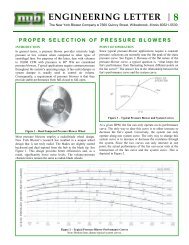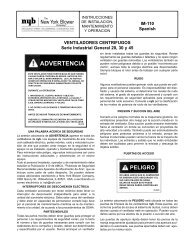Temperature and Altitude Affect Fan Selection - New York Blower
Temperature and Altitude Affect Fan Selection - New York Blower
Temperature and Altitude Affect Fan Selection - New York Blower
Create successful ePaper yourself
Turn your PDF publications into a flip-book with our unique Google optimized e-Paper software.
If Example 2 were such a case, the fan would require 30.0 BHPwhen operating at 70°F., <strong>and</strong> 15.0 BHP when the oven hadwarmed to 600°F. Very often a damper is furnished with the fanso that, during the warming-up period, the fan can be damperedto reduce the horsepower. Without the damper, a 30 HP motorwould be needed.Confusion can be avoided if the SP is specified at the temperatureit was calculated. In Example 2, the specifications should readeither:11,000 CFM <strong>and</strong> 6" SP at 600°F., or11,000 CFM for operation at 600°F. <strong>and</strong> 12" SP at 70°F.Table 1 gives correction factors used to convert from a nonst<strong>and</strong>arddensity to a st<strong>and</strong>ard density of 70°F. air. These factorsare merely the ratios of absolute temperatures. Multiply theactual static pressure by the specific temperature/altitude factorso st<strong>and</strong>ard catalog rating tables can be used. Divide the brakehorsepower from the catalog rating table by thetemperature/altitude factor to get BHP at conditions.Air<strong>Temperature</strong>°F.Table 1 - Corrections for <strong>Temperature</strong>FactorAir<strong>Temperature</strong>°F.Factor-50 0.77 275 1.39-25 0.82 300 1.430 0.87 325 1.48+20 0.91 350 1.5340 0.94 375 1.5860 0.98 400 1.6270 1.00 450 1.7280 1.02 500 1.81100 1.06 550 1.91120 1.09 600 2.00140 1.13 650 2.09160 1.17 700 2.19180 1.21 750 2.28200 1.25 800 2.38225 1.29 900 2.56250 1.34 1000 2.76<strong>Altitude</strong>Feet AboveSea LevelTable 2 - Corrections for <strong>Altitude</strong>Factor<strong>Altitude</strong>Feet AboveSea LevelFactor0 1.00 5000 1.20500 1.02 5500 1.221000 1.04 6000 1.251500 1.06 6500 1.272000 1.08 7000 1.302500 1.10 7500 1.323000 1.12 8000 1.353500 1.14 8500 1.374000 1.16 9000 1.404500 1.18 10000 1.45HOW TO CALCULATE ACTUAL FAN PERFORMANCEAT OTHER THAN SEA LEVELA fan operating at an altitude above sea level is similar to a fanoperating at air temperatures higher than 70°F.; it h<strong>and</strong>les airless dense than st<strong>and</strong>ard. Table 2 gives the ratio of st<strong>and</strong>ard airdensity at sea level to densities of 70°F. air at other altitudes.Example 3. Required: 5800 CFM at 6" SP at 5000 ft. altitude.70°F. air at sea level weighs 1.20 times as much as 70°F. air at5000 Ft. Therefore, at sea level, the SP is 1.2 x 6 = 7.20" SP.The fan would need to be selected for 5800 CFM at 7.2" SP at70°F. .075 density.When both heat <strong>and</strong> altitude are combined, the density of the airis modified by each, independently, so that the correction factorscan be multiplied together.Example 4. Required: 5800 CFM at 6" SP at 5000 ft. altitude at600°F. Air at 70°F. at sea level weighs 2.00 x 1.20 = 2.40 timesas much as 600°F. air at 5000 ft. altitude. At sea level <strong>and</strong> 70°F.,SP = 2.40 x 6 = 14.4" SP. Select a fan for 5800 CFM at 14.4"SP. Divide the brake horsepower in the rating table by 2.40 toobtain horsepower at 600°F. <strong>and</strong> 5000 ft. If the fan is to startcold, it will still be at 5000 ft. altitude. Therefore, to get the“cold” horsepower requirement, divide by 1.20, the altitudefactor only.DENSITY CHANGES FROM OTHER THAN HEAT ANDALTITUDE<strong>Fan</strong> densities may vary from st<strong>and</strong>ard for other reasons than heat<strong>and</strong> altitude. Moisture, gas, or mixtures of gases (other than air)are a few possibilities. In these cases, it is necessary to obtainthe actual density of the airstream gas by some other referencematerial. A similar factor, as shown in Table 1, is then createdusing the st<strong>and</strong>ard density of air .075 lb. per cubic foot divided bythe new density..075 lb./ft. 3Factor = special gas densityACFM-SCFM DEFINITIONThe terms ACFM <strong>and</strong> SCFM are often used in design work <strong>and</strong>cannot be used interchangeably.SCFM is St<strong>and</strong>ard Cubic Feet per Minute corrected to st<strong>and</strong>arddensity conditions. To determine the SCFM of the volume usedin Example 2, which was 11,000 CFM at 600°F., we wouldmultiply the CFM by the density ratios..03711000 x .075= 5500 SCFMThis indicates that if the weight of air at 600°F. were corrected tost<strong>and</strong>ard conditions its volume would be reduced to 5500 CFMACFM st<strong>and</strong>s for Actual Cubic Feet per Minute. It is the volumeof gas flowing through a system <strong>and</strong> is not dependent upondensity.The terms ACFM <strong>and</strong> SCFM are often used in system designwork where both quantities need to be known. It should beremembered, however, that since a fan h<strong>and</strong>les the same volumeof air at any density, ACFM should be used when specifying<strong>and</strong> selecting a fan.Page 2



